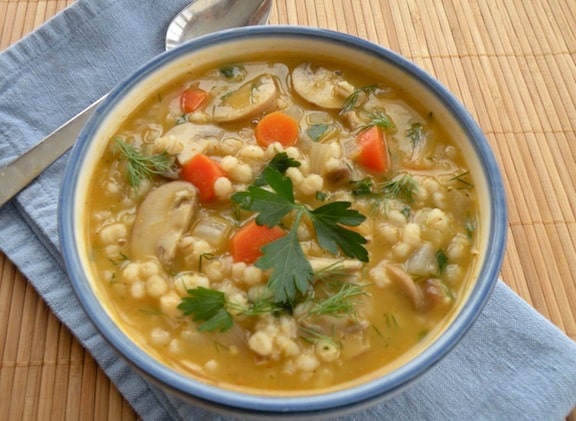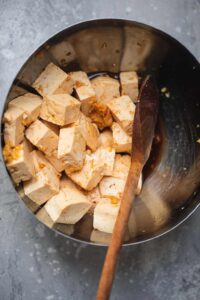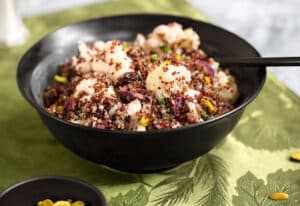Two kinds of barley are available in natural food stores: pearl barley and pot barley, sometimes called Scotch barley. Unhulled barley is occasionally available, but it is not recommended except for the purposes of sprouting , since it takes a very long time to cook–and to chew. The most familiar form of barley is the pearled variety. Pearling is accomplished by grinding off the tenacious hulls of the grain with the use of abrasive disks called carborundum wheels. Pearl barley goes through five or six pearlings, removing all of the hull, plus most of the bran and germ. To make pot or Scotch barley, the grain goes through three pearlings to remove the most of the hull and some of the bran. It is therefore more nutritious than pearl barley.
Don’t assume that just because you buy it in a natural-food store, the grain you have must be the less refined pot barley; make sure it is labeled as such if that is what you want. Pot barley has a deeper tan color than pale pearl barley.
The protein content of pearl barley is 8 percent, whereas that of pot barley is 9 ½ percent. Pot barley is rice in the B vitamins, particularly niacin and thiamine, and provides good quantities of minerals, particularly potassium, as well as iron, phosphorus, and calcium. Pearl barley loses half of the vitamin and mineral content through the removal of the bran a germ. Much of the good fiber content is lost, too.
Basic Cooked Barley: Use 2 ½ to 3 parts water to 1 part grain for pearl barley, and 3 to 3 ½ parts water for pot or Scotch barley, depending on how firm and chewy you like the texture. Bring the water to a boil, then stir in the barley and return to a boil. Lower the heat and simmer, covered, until the water has been absorbed, about 40 minutes for pearl barley and 50 to 55 minutes for pot barley.
- Barley is a favorite soup grain. In addition to the classic mushroom-barley combination, tomato-barley soup are excellent as are bean and barley soups (try adzuki, white, or pinto beans).
- Barley may be used as a substitute for rice in almost any type of recipe–in casseroles, as a bed of grains for vegetable and bean dishes, and as a stuffing for green bell peppers, tomatoes, or other vegetables.
- In hearty stews and casseroles, barley is always compatible with mushrooms, browned onions, and any legume.
- A small quantity of cooked barley added to breads and muffins leans a pleasant, chewy texture.
- Barley is excellent in marinated salads.
Here are a few of VegKitchen’s barley recipes:
- Tomato, Lentil, and Barley Soup
- Barley with Mushrooms and Browned Onions
- Spring Barley Salad with Peas and Asparagus
- Classic Mushroom-Barley Soup
- Barley Salad with Almonds and Apricots
For lots more features on healthy lifestyle, explore VegKitchen’s Healthy Vegan Kitchen page.
Here are more of VegKitchen’s Natural Food Guides.







Comments
No Comments